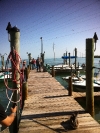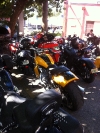Harley-Davidson: The Forgotten Art of the Road Trip
In today’s market, speed rules the conversation. Superbikes, supercars, super(blank) are the center of attention. All marketing materials talk about is going faster and harder. Horsepower, lap times, and what minute difference is going to give one bike an edge is seemingly all we talk about with motorcycles, and what the public sees of us. But beyond the power, speed and fury that few people will use on the street, there is a whole type of riding that goes unnoticed: the road trip.
There used to be a valued segment of the marketplace for “grand tourers.” For cars, these were old Jaguars XK’s and graceful Aston Martins; machines that were built to effortlessly travel long distances with power and grace. As such, they were tuned to deliver a ride that would not rattle every bone in your body to dust. For motorcycles, it has always been the cruiser: Big, bold machines with slow turning engines that produce more torque than power. Many manufactures make bikes built for this segment, but only one has built their reputation on cruisers: Harley-Davidson. On our recent trip to Miami with Harley-Davidson, I discovered the experience of a road trip on a trip from Miami to Key West, and back, in one day.
The U.S. is built for road trips. Our roads are long and flat. Our country is big and wide. Culturally, we have always felt a need to push towards the frontier, and the road trip satisfies that need. It must then be easier to ride long distances than attacking a road course with Red Bull-aided fury since you really are riding in a straight line. But that’s not the case. The experience of a cruise is less technical precision than it is adapting to the little things that get in your way. This is where the difficulty lies.
Take the road itself. Not much attention is paid to it in a car because you don’t feel the differences in the pavement unless you’re in a sports car. On a bike, you feel the difference between where the road has been patched, the seams in the road, gravel, and how it may dip or rise in certain areas, and this all effects how the bike handles. The relationship is much more intense because it changes the way the bike moves.
For this reason, a cruiser is better over a sport bike. Sport bikes are built for maximum road feel so they are affected more by changes in surface. That means they are more jittery and sensitive. A cruiser, on the other hand, is heavier and with a lower center of gravity. As opposed to a sport bike, a cruiser plods along more confidently. This means you spend less time correcting the bikes path and more time enjoying the ride.
But just because you have a cruiser doesn’t mean that road a trip is a time to tune out and stop paying attention. Another small detail that becomes important on a trip is the wind. Again, not something you notice in a car, but a major factor on a bike with no wind protection. It is continually beating you down. Also, there are crosswinds that hit you after traffic passes that you must anticipate and adjust for. The result of just these two small variables is an experience that wears you down over time, rather than in large bursts if pushing the limit on the track. You notice this pain and exhaustion after you sit down at your destination and a day’s worth of effort starts to seep into your muscles.
You might be wondering, how is this supposed to be fun in the slightest? But the pain is part of the fun. Anyone can drive long distances in a car, but it takes a real effort and certain personality type to do it on a bike. This makes it more of an accomplishment. Also, as opposed to blitzing across long distances in a car, you stop in increments along the journey on a bike, adding to the story. You also interact with the machine you are on and the riders you are with. Not from a conversation standpoint, but an unspoken relationship where you begin to trust your group and bike more because of the time you put in together on a trip.
And there is no better feeling than that one moment of nirvana. For me, it was cruising back from the Keys back to Miami. The sun was setting, I was comfortable on the bike, and the temperature had cooled down. At that moment, cruising made sense to me. It is a moment where you feel completely insignificant as you look out over the horizon and notice just how small you are. But you also feel empowered, and yes, a little bit badass.
When it comes to cruising, a Harley is built for this experience. Not from a mere technical standpoint, but an emotional one. The look, sound and feel I was talking about in my first article transfers to how you ride the bike on the road. The way the motor reacts to more throttle, the way the brakes feel, and the way the suspension is tuned makes more sense on the open road in a Harley than it does around town. The sensitivity that is not there around town helps you on long journeys. They provide more wiggle room to be more forgiving of mistakes and more comfortable to use over long distances.
At the end of a cruise you have a story, not just a lap time, and that’s why you should try a road trip no matter what bike you ride. But of course, it doesn’t hurt to make that bike a Harley.
Related Posts
You can follow us on Twitter and Facebook for content updates. Also, sign up for our email list for weekly updates and check us out on Google+ as well.
Posted in: Lifestyle, Motorcycles
Tags: Harley Davidson, Harley in Miami, motorcycle road trips





















